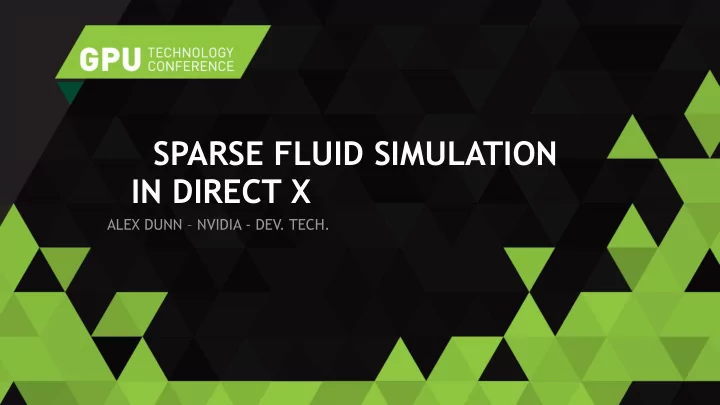

SPARSE FLUID SIMULATION IN DIRECT X ALEX DUNN – NVIDIA - DEV. TECH.
AGENDA Fluid in games. Eulerian (grid based) fluid. Sparse Eulerian Fluid. Feature Level 11.3 Enhancements!
WHY DO WE NEED FLUID IN GAMES? Replace particle kinematics! more realistic == better immersion Game mechanics? occlusion smoke grenades physical interaction Dispersion air ventilation systems poison, smoke Endless opportunities!
EULERIAN SIMULATION #1 My (simple) DX11.0 eulerian fluid simulation: 2x Velocity Inject Advect 2x Pressure Pressure Vorticity 1x Vorticity Evolve
EULERIAN SIMULATION #2 Add fluid to simulation Inject Move data at, XYZ (XYZ+Velocity) Advect Calculate localized pressure Pressure Calculates localized rotational flow Vorticity Tick Simulation Evolve
**(some imagination required)**
TOO MANY VOLUMES SPOIL THE… Fluid isn’t box shaped. clipping wastage Simulated separately. authoring GPU state no volume-to-volume interaction Tricky to render.
PROBLEM! Texture3D - 4x16F N-order problem 8192 7168 64^3 = ~0.25m cells 6144 128^3 = ~2m cells Memory (Mb) 5120 256^3 = ~16m cells 4096 3072 … 2048 Applies to: 1024 0 computational complexity 0 256 512 768 1024 Dimensions (X = Y = Z) memory requirements And that’s just 1 texture…
BRICKS Split simulation space into groups of cells (each known as a brick). Simulate each brick independently.
BRICK MAP Need to track which bricks contain fluid Texture3D<uint> 1 voxel per brick 0 Unoccupied 1 Occupied Could also use packed binary grids [Gruen15], but this requires atomics
TRACKING BRICKS Initialise with emitter Expansion ( unoccupied occupied ) if { V |x|y|z| > |D brick | } expand in that axis Reduction ( occupied unoccupied ) inverse of Expansion handled automatically
SPARSE SIMULATION Clear Bricks Reset all bricks to 0 (unoccupied) in Inject brick map. Advect Texture3D<uint> g_BrickMapRO; Pressure Read value from AppendStructredBuffer<uint3> g_ListRW; brick map. Vorticity if(g_BrickMapRO[idx] != 0) Append brick Evolve* { coordinate to list g_ListRW.Append(idx); if occupied. Fill List } *Includes expansion
UNCOMPRESSED STORAGE Allocate everything; forget about unoccupied cells Pros: simulation is coherent in memory. • works in DX11.0. • Cons: no reduction in memory usage. •
COMPRESSED STORAGE Similar to, List<Brick> Indirection Table Pros: good memory consumption. • works in DX11.0. • Cons: allocation strategies. Physical Memory • indirect lookup. • “software translation” • filtering particularly costly •
1 Brick = (4) 3 = 64
1 Brick = (1+4+1) 3 = 216 • New problem; • “6n 2 +12n + 8” problem. Can we do better?
ENTER; FEATURE LEVEL 11.3 Volume Tiled Resources (VTR)! Extends 2D functionality in FL11.2 Must check HW support: (DX11.3 != FL11.3) ID3D11Device3* pDevice3 = nullptr; pDevice-> QueryInterface (&pDevice3); D3D11_FEATURE_DATA_D3D11_OPTIONS2 support; pDevice3-> CheckFeatureSupport (D3D11_FEATURE_D3D11_OPTIONS2, &support, sizeof(support)); m_UseTiledResources = support.TiledResourcesTier == D3D11_TILED_RESOURCES_TIER_3;
TILED RESOURCES #1 Pros: only mapped memory is • allocated in VRAM “hardware translation” • logically a volume texture • all samplers supported • 1 Tile = 64KB (= 1 Brick) • fast loads •
TILED RESOURCES #2 1 Tile = 64KB (= 1 Brick) BPP Tile Dimensions 8 64x32x32 16 32x32x32 32 32x32x16 64 32x16x16 128 16x16x16 Gotcha: Tile mappings must be updated from CPU
CPU READ-BACKS Taboo in real time graphics CPU read-backs are fine, if done correctly! (and bad if not) 2 frame latency (more for AFR in SLI) Profile map/unmap calls N+1; N; N+2; Data Ready Data Ready Data Ready CPU: Frame N Frame N+1 Frame N+2 Frame N+3 GPU: Frame N Frame N+1 Frame N+2 N; Tiles Mapped
LATENCY RESISTANT SIMULATION #1 Naïve Approach: clamp velocity to V max CPU Read-back: occupied bricks. 2 frames of latency! extrapolate “probable” tiles.
LATENCY RESISTANT SIMULATION #2 Tight Approach: CPU Read-back: occupied bricks. max{|V|} within brick. 2 frames of latency! extrapolate “probable” tiles.
LATENCY RESISTANT SIMULATION #3 CPU Readback Ready? Yes No Sparse Readback Emitter Eulerian Brick List Bricks CPU Simulation GPU Prediction Engine UpdateTile Mappings
DEMO
PERFORMANCE #1 64.7 Sim. Time (ms) 19.9 Full Grid Sparse Grid 6.0 2.3 2.9 2.7 1.8 0.4 128 256 384 512 1024 Grid Resolution NOTE: Numbers captured on a GeForce GTX980
PERFORMANCE #2 40,960 Memory (MB) 5,120 2,160 640 138 80 83 57 46 Full Grid 11 Sparse Grid 128 256 384 512 1024 Grid Resolution NOTE: Numbers captured on a GeForce GTX980
SCALING Time{Full} Ratio (in time) of 1 Brick = Time{Sparse} ~75% across grid resolutions.
SUMMARY Let’s see more fluid in games. Fluid is not box shaped! One volume is better than many small. Un/Compressed storage a viable fallback. CPU read-backs are useful if done right! VTRs great for fluid simulation. Other latency resistant algorithms with tiled resouces?
THANK YOU ALEX DUNN - ADUNN@NVIDIA.COM TWITTER: @ALEXWDUNN
Recommend
More recommend